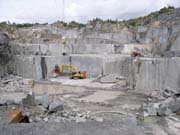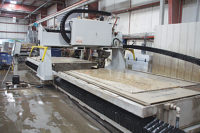
Even though the stones from the Larvik region of Norway have been quarried for centuries, there are still some relative newcomers in the game who have taken the right approach. Founded in 1987, Larvik Granite AS has always made sure that its equipment represents the latest generation of machinery in the marketplace, and it has also worked with manufacturers in a collaborative effort to meet production and quality goals.
The company has quarries for Silver Pearl, Blue Pearl, Emerald Pearl and Blue Antique granite, which is similar to Labrador Antique. It also supplies Norwegian Rose and Arctic White marble (which come from the same quarry), as well as Lapponia Green. Larvik Granite's office is only two minutes from the blockyard, and production is shipped directly from the port in Larvik.
Most of the quarries are only 15 minutes away from the offices, and the company regularly receives visitors from around the world. Many of these guests receive their first impression of Larvik Granite's materials at nearby Sandjeford Airport, where the company supplied a carving of an airplane made from local granite. The base of the airplane is Blue Pearl, and the plane itself is Blue Antique.
The quarries operate year round, and Larvik Granite reports that it has a 19.7% market share of Norway's granite exports. In general, China is the largest export market for Norway, having exceeded Italy. Torger Lingelem, marketing director for Larvik Granite said that the stoneworking region of Xiamen, China, is increasing its exports, and is continually looking for gangsaw-sized blocks. However, being one of the youngest companies in Larvik, the company is also looking for new markets, such as Belgium, France and Turkey, which are increasing their block imports as well. Of course, many of the granites from Norway ultimately end up in the U.S. as finished products after they are processed in block form elsewhere.
Larvik Granite's greatest challenge is not just maintaining its sales relationships, but also having large quantities of high-quality stone, explained Lingelem and Johan Kr. Haugene, the company's managing director. “The world's use of stone is increasing,†Lingelem said. “Increases in production in Larvik alone will not keep up with this demand. We need to find new sources.†Toward that end, the company recently opened a new quarry for Emerald Pearl granite, and it acquired a site for Silver Pearl granite five years ago.
During the production process in the quarries, the first step is to drill pilot holes for the diamond wire saws. These wires cut out large “slabs†measuring 8 x 10 x 2 meters. Overall, the company is advanced in terms of automation, and U.S. quarries come to learn the methods, Lingelem said. There is not much need for blasting, other than in new areas with overburden, and even the horizontal cutting is done with diamond wire saws, which is a more environmentally friendly method. The typical block size is 3 m x 180 cm x 180 cm.
The company has 60 workers in all, and to keep its quarry workers in touch with modern technology, all of the employees have company-issued personal computers. They also receive benefits from a profit-sharing plan.

New drilling systems
One of the newest developments for Larvik Granite can be found at its quarry for Blue Pearl granite, where it has added a Trimmer 440 drilling unit from Tamrock of Finland. This unit is used for secondary drilling and trimming of large blocks, which are split into 50-ton sections that can be carried by a wheel loader. In the automatic mode, the machine takes care of the full frame length of holes.The Trimmer 440 is equipped with four HEX1 drifters that run on a rail, operating by radio control. The rail is aligned with the help of a laser beam, and the drifters move in a sequence for optimum speed. The four drifters are arranged in pairs, although each can move up and down independently, and the machine operates in three modes: automatic, semi-automatic and manual. In the automatic mode, the machine takes care of the full frame length of holes.
During the machine's operation, the first step is rough positioning of the frame, which is then aligned with the help of two built-in lasers guides. After being properly aligned, the hydraulic legs are lowered and the drill line length is set. Then the hole spacing and depth are programmed on the machine's console, and the unit is started by remote control.
The drifters are 2.4 meters in size, resulting in penetration of 2.1 meters. The machine's horizontal reach is 12.5 meters with a typical excavator and boom arrangement. The unit can work at a 30-degree tilt if needed, and it can also swing 30 degrees as required.
Due to a frame size of 4.6 meters, the unit can drill a block as wide as 4.2 meters without being repositioned. Typically, it takes 20 to 22 minutes to completely drill a block 4.2 meters in length, and it has greatly reduced labor requirements.
In developing the Trimmer 440 to fit the needs of the quarry, representatives from Tamrock came to Norway to perfect the controls and other machine details. Professionals from Tamrock and from Larvik Granite discussed the proper frame size and the specifications for the drifters, as well as the proper configuration for the remote control, which has a joystick for simple operation.
The first Trimmer 440 was installed in July of 2004, and a second was purchased for the company's Silver Pearl quarry in October. Additionally, the company may be adding one or two more units this year.
Another advance at the quarries is the way the massive slabs of stone are split from the quarry face. Historically, iron “pillows†were inflated with water to create an opening. Today, however, a hydraulic rake has been developed, which allows the quarry workers to hydraulically pull large slabs of stone from the quarry face. This is a more efficient and safer method, requiring only five minutes to complete.
Given the massive amount of waste at the quarry, properly removing unusable stone and maintaining the landscape are a major task. In one initiative, the waste is covered with a soil derived from agricultural byproducts, which results in wildflowers. A landscape architect was involved with this project. In the future, the company is considering the installation of a conveyor that can run directly to the harbor.
The Blue Pearl quarry -- which is being worked on nine different levels -- has an annual production total of 6,000 cubic meters. A total of 20 people work in the Blue Pearl quarry, which has four strict color classifications.
The quarry also has a small production plant, equipped with Pellegrini stationary diamond wire saws, which cut the irregular ends of the slabs to produce useable “slabs.†The saw's block trolley rotates so that all four sides of the block can be cut. Outside of this plant, the company has a dedicated block controller, and blocks are tracked in a computer terminal and recorded on a handheld device that notes the block dimensions, type, quality and even the veining patterns.
New developments
Larvik Granite has also been active in developing and acquiring quarries to boost production. In 2003, the company began quarrying Emerald Pearl granite at a virgin site. “It took six years to get a quarrying permit, and we had to remove 40,000 tons of clay,†Lingelem said, adding that the new site is very environmentally conscious, as all waste leaves the site and is eventually crushed for gravel. Water is also recycled according to strict standards.This quarry uses the same production technique as other sites, relying on diamond wire saws for most of the cutting operations. Investments in machinery for this site include a Tamrock Ranger 500, which is used for drilling the pilot holes. The unit has a swing head for drilling both vertically and horizontally, and it is enclosed with a heated cabin.
There are a total of 10 workers in the new Emerald Pearl quarry, and they can do multiple tasks on the job.
Overall, the new quarry is yielding blocks of suitable sizes, and production stands at 4,500 cubic meters per month. However, the company is confident that the production will improve in terms of quality and volume in the coming years. Lingelem said that it takes three to four years to develop a quarry nowadays, where as it may have taken as much as 10 years only a short while ago. “You cannot afford to wait to develop a quarry,†he said.
Another quarry that is continually being upgraded with new technology is a site for Silver Pearl granite, which Larvik Granite acquired from another company in 1999. The company used to have 13 people under the old ownership, but with the new technology in place, it only requires eight workers. The quarry workers are moved from the different sites as needed, which allows the company to maintain the overall staff rather than lay workers off as the demand for materials shifts.
Equipment in use at the quarry includes a Tamrock Ranger 500 for drilling pilot holes, along with an entire range of other Tamrock drilling rigs. Additionally, the company has developed its own splitting unit.
At the Silver Pearl quarry, the company can work many levels at once. At the time of Stone World's visit, for example, crews were working on six different levels. The Silver Pearl quarry has 6,000 to 7,000 cubic meters of annual production, although this can increase to 10,000 to 12,000 cubic meters in only two years.
Larvik Granite is enthusiastic about the Silver Pearl granite quarry's potential, because the relatively lower production cost can yield higher profits. The granite can be sold for a lower price than other varieties in the region, and its color works well with other elements, such as stainless steel. Also, the Silver Pearl and Emerald Pearl quarries have a waste factor of only 85%, as compared to the waste factor of 95 to 97% associated with Blue Pearl quarrying.
Outside of the Larvik area, the company's Blue Antique quarry yields 2,000 cubic meters per year. The stone features natural blue, black and green veins, and the quality is improving while the price is going down, Larvik Granite reports.
